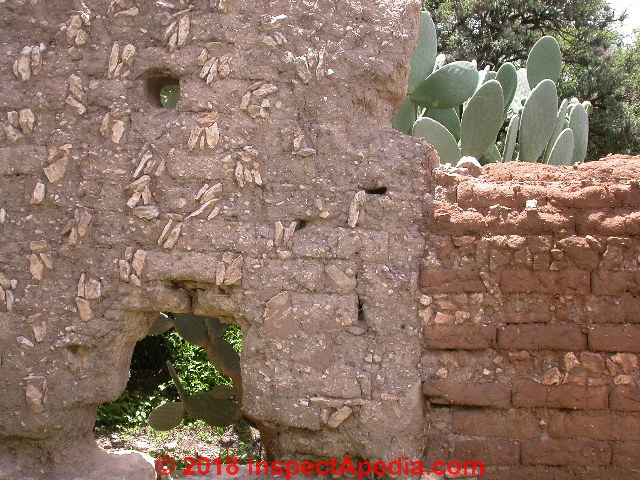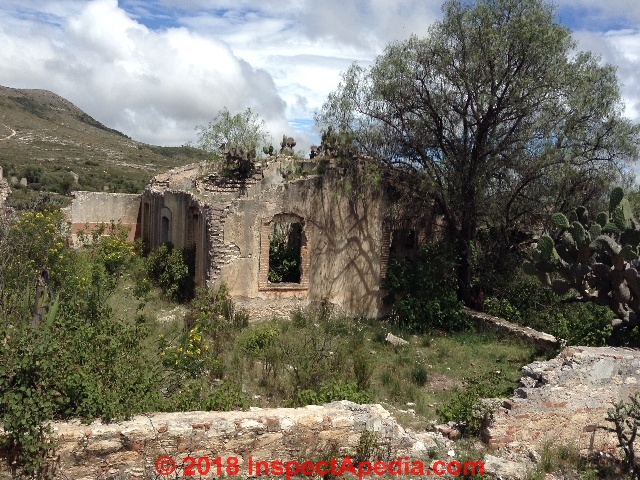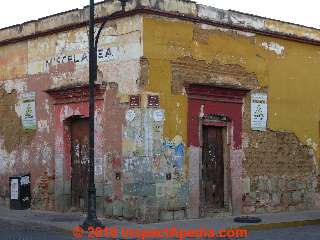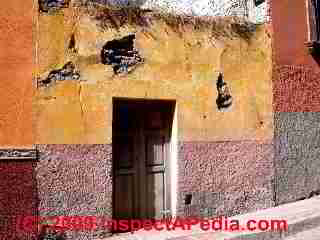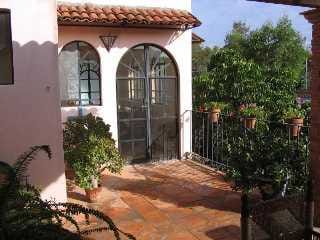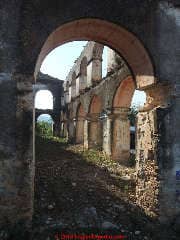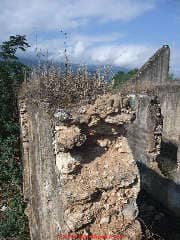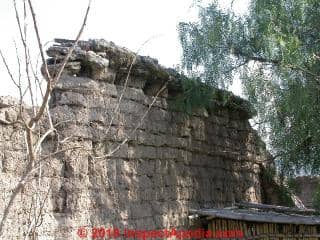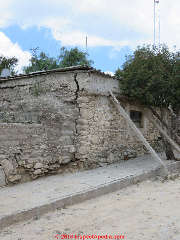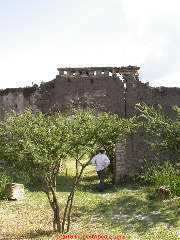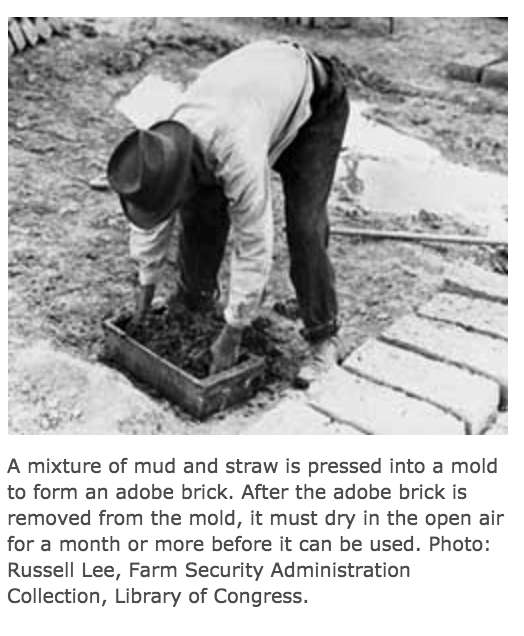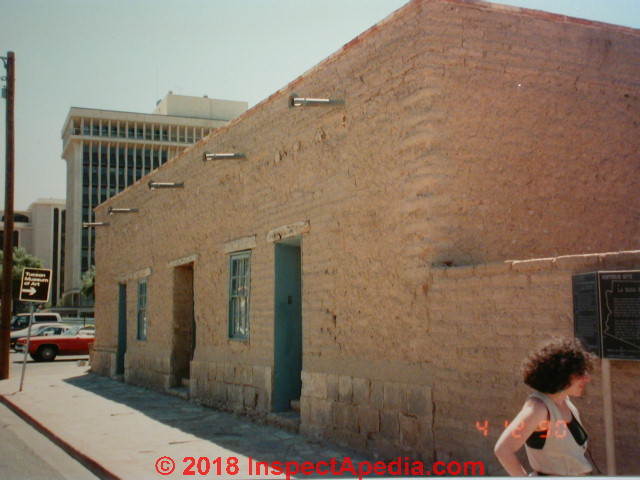 Adobe Construction
Adobe Construction
in North America
- POST a QUESTION or COMMENT about components, systems, or materials of adobe construction
Adobe building construction types, history, identification & repair guide.
Photos of antique and modern adobe-constructed buildings in North America. We also provide links to articles on adobe construction, adobe repair, the preservation of historic adobe structures, and the history of adobe construction in the United States and Mexico.
Photo above: Laura Waterman outside a traditional adobe building in Tucson, Arizona. This adobe house was named for Maria Navarette Cordova whose family acquired the home in 1896. - source: Tucson-Pima County Historical Commission & the Arizona Historical Society.
This article series provides a photo guide to determining the age of a residential or light commercial building by examination of the architectural style of construction or the building materials and components that were used in the structure.
InspectAPedia tolerates no conflicts of interest. We have no relationship with advertisers, products, or services discussed at this website.
- Daniel Friedman, Publisher/Editor/Author - See WHO ARE WE?
Adobe construction in North America
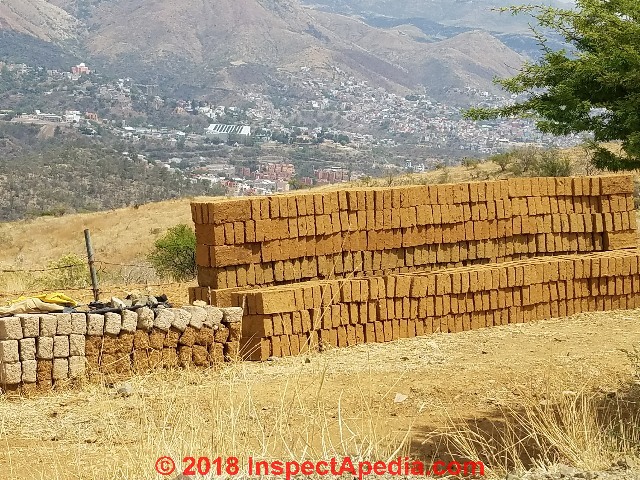
Definition of Adobe
Adobe, from the Spanish adobe or mud brick, is a building material, typically in large earthen-brick form, made frrom a mixture of water, about 15% earth or clay, about 10-30% silt,and about 55-75% sand.
Adobe bricks typicaly include also materials for structural strength such as straw, pebbles, shells, manure, and other organics. The asobe bricks are dried in the sun to a hardened form.
In construction of walls, adobe bricks are set using a bedding mortar of the same type of mud as was used to form the adobe bricks themselves.
Photo: adobe bricks drying in the sun at Los Olivos, above the city of Guanajuato, Mexico. These adobe bricks vary in size, even in the same production run, as shown in our photo, and adobe will vary as well as in constituents - also shown in the photo.
In Mexico adobe bricks may weigh 25 pounds or considerably more, with large adobe bricks weighing as much as 100 pounds.
In size adobe bricks vary from about 4x8x12" (small adobe bricks) to much larger sizes. Some adobe builders use wider rectangular adobe such as New Zealand's Solid Earth builders providing square 280x280x130mm building adob e bricks along with larger 430x280x130mm corner adobe bricks.
Shaped and compacted earth was used as early as 8300 B.C. as a construction material for the ancient city of Jericho. (Bowen 2017)
Adobe construction has been used world wide since pre-historic times to build structural walls and floors, arches, towers, and for Arizona's Anasazi, grain storage facilites mid-way up the walls of the Grand Canyon (200 BC - 1500AD). Adobe structures that are protected from the weather can survive for more than 100 years.
Below: an Anasazi corn storage crib using stone and adobe in the Grand Canyon, photographed by the author in July, 1991.
Composition of Adobe
The most desirable soil texture for producing the mud of adobe is 15% clay, 10–30% silt, and 55–75% fine sand.
Another source quotes 15–25% clay and the remainder sand and coarser particles up to cobbles 50 to 250 mm (2 to 10 in), with no deleterious effect.
Modern adobe is stabilized with either emulsified asphalt or Portland cement up to 10% by weight.
No more than half the clay content should be expansive clays, with the remainder non-expansive illite or kaolinite.
Too much expansive clay results in uneven drying through the brick, resulting in cracking, while too much kaolinite will make a weak brick.
Typically the soils of the Southwest United States, where such construction has been widely used, are an adequate composition. ] - Wikipedia, retrieved 2018/06/18, original source: https://en.wikipedia.org/wiki/Adobe
Types of Damage to Adobe Structures
Above: remains of a 19th century adobe structure remaining outside of Mineral de Pozos, nee Mineral de San Pedro de los Pozos, a silver mining center in Guanajuato, Mexico.
At its peak, Pozos was populated by silver, copper, zinc, and mercury mine workers and was home to about 80,000 people. 13,000 Pozos miners died in a tragic flood during the Mexican revolution.
Pozos was more-recently a ghost town and currently a small but growing tourist destination. When Europeans arrived at Pozos (wells) in 1576 the area had been settled for centuries by Chichimecas and Huachichiles and their ancestors.
Stucco Failures on Adobe Walls
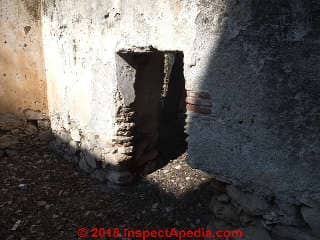 dobe structures, roofed and stuccoed, can be very durable, lasting 100 years or longer, and offering considerable advantages including use of inexpensive local materials and the temperature-regulating comfort of thermal mass.
dobe structures, roofed and stuccoed, can be very durable, lasting 100 years or longer, and offering considerable advantages including use of inexpensive local materials and the temperature-regulating comfort of thermal mass.
But the adobe durability story changes when there is a roof or wall leak, or where surface runoff or rain splash-up wear the bottom of an adobe wall.
Adobe structures are usually coated on the exterior and interior with a stucco mixture of cement, plaster or similar substances.
Stucco on adobe suffers different problems from stucco systems on framed walls. On adobe, the most common stucco coating failure I see is adhesion loss, usually when rain water penetrates the stucco wall coating.
That may explain the loss of the stucco coating on the adobe wall of the adobe and stone structure in Jalpan, Queretaro, Mexico, shown in our preceding photo.
Below: A traditional adobe structure in Tucson, Arizona in 1990, photo by the author.
La Casa Cordova includes remaining portions of one of the oldest still-standing structures in Tucson, believed to have been built before the Gadsen Purchase in 1854.
Photo below: an antique adobe structural wall with cement stucco coating in Oxaca, Mexico. I first visited this building in Oxaca 1960. I visited it again, finding it in its present condition in 2016.
This is the most common failure I see is stucco-coating adhesion loss, usually when rain water penetrates the stucco wall coating.
The adobe building shown below, located in San Miguel de Allende, Guanajuato,Mexico, is ready for repair and re-painting.
Unlike the stucco on steel or wood-framed buildings in colder climates, none of the stucco-coated traditional adobe structures I've inspected in several countries has used flashings around windows or doors. Cement stucco is applied directly in one or two coatings to the exterior of the adobe walls.
The paint wear or failure including painting and stucco-coating loss are discussed
Below: an adobe and concrete-hybrid home constructed in the same city in 1960. This home is described also
Structural Damage & Collapsing Adobe Walls
Below are photographs of antique adobe structures at Jalpan in Queretaro, Mexico.
Usually on an adobe structure that is not maintained, the roof collapses and disappears first.
Then, as you see in our detailed photo above, the adobe wall structure, exposed to the weather, begins to collapse.
Below: you can see the remains of roof beam pockets in the top of this adobe wall at el Charco del Ingenio, San Miguel de Allende, Guanajuato, Mexico. The protective stucco coating has long fallen away.
Less often we find severe stuctural damage to an adobe wall, usually where the wall base has been undermined by surface runoff.
Our photo below shows temporary bracing supporting a cracked, leaning adobe structural wall in Pozos, Mexico, an antique silver mining center.
Our next photo, below, shows the remains of an 19th century hacienda wall built of adobe at el Charco del Ingenio, San Miguel de Allende, Guanajuato, Mexico.
Adobe Structure Build, Repair & Preservation Resources
Illustrations: Traditional Adobe Construction, Russell Lee, Farm Security Administratin, Library of Congress, excerpted from the NPS Preservation brief cited just below.
- "Adobe, Past and Present." Reprinted from El Palacio. Vol. 77, no. 4 (1971).
- Austin, George. ADOBE as a BUILDING MATERIAL [PDF] New Mexico Geology, November 1984. New Mexico Bureau of Mines and Mineral Resources. p. 70. Archived from the original (PDF) on 2 December 2013. Retrieved 27 February 2013.
Introduction:
Adobes are dried mud or unburned bricks that have been used for thousands of years in the construction of dwellings and bther structures.
Even today the majority of the people in the world use mud-brick construction.
The term adobe generally is used to describe various building materials made of earth and the techniques for using these materials. Most often it refers to sun-dried brick, currently the most widely used in the United States,
but puddled earth material, mudplastered logs or branches, cut soil horizons, and even rammed-earth construction also can be identified as adobe.
Generally, any strucfure that has been made with soil or mud as a primary building material is considered to be adobe. - Barnes, Mark R. "Adobe Bibliography." The Association for Preservation Technology Bulletin. Vol. 7, no. 1 (1975).
- Boundreau. E. H. Making the Adobe Brick. Berkeley, Calif.: Fifth Street Press, 1971
- Bowen, Thomas, A BEST PRACTICES MANUAL FOR USING
COMPRESSED EARTH BLOCKS IN SUSTAINABLE
HOME CONSTRUCTION IN INDIAN COUNTRY [PDF], (2017) U.S. Department of Housing and Urban Development, HUD, Thomas Bowen, University of Colorado, Boulder, retrieved 2018/06/18, original source: https://www.huduser.gov/portal/sites/default/files/pdf/Compressed-Earth-Blocks.pdf
Excerpt:
Compressed earth blocks (CEBs) are a natural infusion of modern technology with one of the earliest elements of manmade structures: the mud brick or adobe block.
CEBs are essentially molded adobe blocks produced using mechanical compaction. Shaped and compacted earth was used as early as 8300 B.C. as a construction material for the ancient city of Jericho, near what is now Jordan.
Taos Pueblo in northern New Mexico is the largest surviving multistoried adobe structure and the oldest continuously inhabited adobe site in the United States. - Carpenter, Jennifer Lynn, DIRT CHEAP: THE GARDENDALE EXPERIMENT AND RAMMED EARTH HOME CONSTRUCTION IN THE UNITED STATES [PDF], Masters Final Project submitted to the Faculty of the Graduate School of the University of Maryland, College Park, in partial fulfillment of the requirements for the degree of Master in Historic Preservation 2010, retrieved 2018/06/18, original source: https://drum.lib.umd.edu/bitstream/handle/1903/10740/Carpenter_DRUM.pdf;sequence=1
- Clifton, James R. Preservation of Historic Adobe Structures: A Status Report. Washington, D.C.: National Bureau of Standards Technical Note 934, US Government Printing Office, Stock No. 003-00301740-0, Feb. 1977.
- Grimmer, Anne E., The PRESERVATION & REPAIR of HISTORIC STUCCO [PDF], National Park Service Preservation Brief No. 22., retrieved 2018/06/18, original source: https://www.nps.gov/tps/how-to-preserve/briefs/22-stucco.htm
- Eyre, T. A. "The Physical Properties of Adobe Used as a Building Material." The University of New Mexico Bulletin. Engineering Series. Vol. 1, no. 3 (1935).
- Garrison, James, ADOBE, the MATERIAL, ITS DETERIORATION, ITS COATINGS, [PDF] (powerpoint type presentation slildes), retrieved 2018/06/18, original source: http://missions.arizona.edu/sites/default/files/1%20Garrison-Adobe%20Characteristics.pdf
- George, Eugene. "Adobe Bibliography." The Association for Preservation Technology Bulletin. Vol. 5, no. 4 (1974).
- Haapala, K. V. "Stabilizing and Restoring Old Adobe Structures in California." Newsletter of the National Association of Restoration Specialists. Murphy, Calif., June 1972.
- Hubbell, E., Earth Brick Construction: U.S. Office of Indian Affairs, Home Improvement Pamphlet 1943, 1, 110 pp
- McHenry, Paul Graham, Jr. Adobe—Build It Yourself. Tucson, Ariz.:University of Arizona Press, 1973
- Schroder, Lisa, and Vince Ogletree. Adobe homes for all climates: simple, affordable, and earthquake-resistant natural building techniques. Chelsea Green Publishing, 2010.
- Smith, E. W., Adobe bricks in New Mexico: New Mexico Bureau of Mines and Mineral Resources, 1982, Circular 188, 89 pp.
- Solid Earth, Main Road, Wakapuaka, RD1 Nelsonn, New Zealand phone: (03) 545 0240 mobile: 021-036 3938 e-mail: contact@SolidEarth.co.nz Website: http://www.solidearth.co.nz/
Provides Solid Earth Adobe Buildings, Earthbuilding Construction and Adobe Brick Manufacture - US NPS, PRESERVATION OF HISTORIC ADOBE BUILDINGS [PDF] (1978) Preservation Briefs No. 5, U.S. National Park Service, Technical Preservation Services, retrieved 2022/10/02 original source: https://www.nps.gov/tps/how-to-preserve/briefs/5-adobe-buildings.htm
Excerpts:
The adobe, or sun-dried brick, is one of the oldest and most common building materials known to man.
Traditionally, adobe bricks were never kiln fired. Unbaked adobe bricks consisted of sand, sometimes gravel, clay, water, and often straw or grass mixed together by hand, formed in wooden molds, and dried by the sun.
Today some commercially available adobe-like bricks are fired. These are similar in size to unbaked bricks, but have a different texture, color, and strength.
Similarly some adobe bricks have been stabilized, containing cement, asphalt. and/or bituminous materials, but these also differ from traditional adobe in their appearance and strength.
Traditional adobe construction techniques in North America have not varied widely for over 3-1/2 centuries. Adobe building methods employed in the Southwest in the 16th century are still used today. - US NPS, PRESERVATION OF HISTORIC ADOBE BUILDINGS - ORIGINAL [PDF] (1978) Preservation Briefs No. 5, U.S. National Park Service, Technical Preservation Services, retrieved 2018
- Vargas, J., J. Bariola, M. Blondet "Seismic Strength of Adobe Masonry". Materials and Structures. 9 (4): 253–256. (1986).
Abstract:
The most important soil characteristies [sic] from the viewpoint of the strength of adobe masonry are first studied.
Subsequently, based on the acquired knowledge, the effect of some natural additives to the soil is investigated.
Simple field tests, devised to identify the most adequate materials for adobe construction and to be easily transmitted to the potential adobe builder are finally proposed. - Wilson, Quentin, ""Mass and insulation with adobe". Green Home Building.
...
Continue reading at ARCHITECTURE, STYLE, & BUILDING AGE or select a topic from the closely-related articles below, or see the complete ARTICLE INDEX.
Or see these
Recommended Articles
- AGE of a BUILDING, HOW to DETERMINE - home
- ARCHITECTURE & BUILDING COMPONENT ID - home
- ARCHITECTURE DICTIONARY of BUILDINGS & COMPONENTS
- ARCHITECTURE, STYLE, & BUILDING AGE
- CLAY HOLLOW TILE CONSTRUCTION
- PAINT on STUCCO, FAILURE - common causes of paint failure in stucco coatings
- PLASTER TYPES & METHODS in BUILDINGS
- SIDING EIFS & STUCCO - home
- STONE, STUCCO & BRICK CLEANING METHODS
- STUCCO RECIPES & APPLICATION
- STUCCO on ADOBE STRUCTURES found
in STUCCO WALL METHODS & INSTALLATION - protective coatings that may apply to adobe as well as other building structures. - THERMAL MASS in BUILDINGS - adobe structures have considerable thermal mass.
Suggested citation for this web page
ADOBE CONSTRUCTION at InspectApedia.com - online encyclopedia of building & environmental inspection, testing, diagnosis, repair, & problem prevention advice.
Or see this
INDEX to RELATED ARTICLES: ARTICLE INDEX to BUILDING ARCHITECTURE
Or use the SEARCH BOX found below to Ask a Question or Search InspectApedia
Or see
INDEX to RELATED ARTICLES: ARTICLE INDEX to BUILDING DAMAGE, DISASTER, REPAIRS
Or use the SEARCH BOX found below to Ask a Question or Search InspectApedia
Ask a Question or Search InspectApedia
Questions & answers or comments about identifying the age of a building or its components, systems, or materials of construction
Try the search box just below, or if you prefer, post a question or comment in the Comments box below and we will respond promptly.
Search the InspectApedia website
Note: appearance of your Comment below may be delayed: if your comment contains an image, photograph, web link, or text that looks to the software as if it might be a web link, your posting will appear after it has been approved by a moderator. Apologies for the delay.
Only one image can be added per comment but you can post as many comments, and therefore images, as you like.
You will not receive a notification when a response to your question has been posted.
Please bookmark this page to make it easy for you to check back for our response.
IF above you see "Comment Form is loading comments..." then COMMENT BOX - countable.ca / bawkbox.com IS NOT WORKING.
In any case you are welcome to send an email directly to us at InspectApedia.com at editor@inspectApedia.com
We'll reply to you directly. Please help us help you by noting, in your email, the URL of the InspectApedia page where you wanted to comment.
Citations & References
In addition to any citations in the article above, a full list is available on request.
- Association for Preservation Technology International 3085 Stevenson Drive, Suite 200 Springfield, IL 62703 Tel: 217-529-9039 Fax: 217-529-9120 Email: info@apti.org , Website: https://www.apti.org/
- Building Technology Heritage Library (Web: https://archive.org/details/buildingtechnologyheritagelibrary ) , produced by the Association for Preservation Technology, is a superb resource for old building researchers, owners, or restorers. website: https://archive.org/details/buildingtechnologyheritagelibrary
This library offers large collection of books (over 8000 in July of 2016), catalogs and other documents that are provided free to the public in a variety of electronic forms such as in PDF format or as .epub documents. The collection includes documents that are rarely found in other libraries nor in other online collections for preservationists.
Excerpt:
The Building Technology Heritage Library (BTHL) is primarily a collection of American and Canadian, pre-1964 architectural trade catalogs, house plan books and technical building guides. Trade catalogs are an important primary source to document past design and construction practices. These materials can aid in the preservation and conservation of older structures as well as other research goals. About the Building Technology Heritage Library The BTHL contains materials from various private and institutional collections. These materials are rarely available in most architectural and professional libraries.
Note: On the home page for each item, there is a section as the bottom called "Reviews" It will list previous comments or ask "Be the first person to write a review." Please comment about items, as this helps the library and association better understand their users.
Special thanks to Mike Jackson, FAIA American architect and InspectApedia reader for suggesting this superb resource. Mr. Jackson can be contacted by email at arch419@aol.com - Mark Cramer Inspection Services Mark Cramer, Tampa Florida, Mr. Cramer is a past president of ASHI, the American Society of Home Inspectors and is a Florida home inspector and home inspection educator. Mr. Cramer serves on the ASHI Home Inspection Standards. Contact Mark Cramer at: 727-595-4211 mark@BestTampaInspector.com
- John Cranor [Website: /www.house-whisperer.com ] is an ASHI member and a home inspector (The House Whisperer) is located in Glen Allen, VA 23060. He is also a contributor to InspectApedia.com in several technical areas such as plumbing and appliances (dryer vents). Contact Mr. Cranor at 804-873-8534 or by Email: johncranor@verizon.net
- Carson Dunlop, Associates, Toronto, have provided us with (and we recommend) Carson Dunlop Weldon & Associates'Technical Reference Guide to manufacturer's model and serial number information for heating and cooling equipment ($69.00 U.S.). Technical Reference Guide, Carson Dunlop Weldon & Associates, Ltd., 120 Carlton St. Suite 407, Toronto, Ontario, M5A 4K2 Canada, ISBN 1-895585-90-2 165pp.
- America's Favorite Homes, mail-order catalogues as a guide to popular early 20th-century houses, Robert Schweitzer, Michael W.R. Davis, 1990, Wayne State University Press ISBN 0814320066 (may be available from Wayne State University Press)
- Building Research Council, BRC, nee Small Homes Council, SHC, School of Architecture, University of Illinois at Urbana-Champaign, brc.arch.uiuc.edu. "The Small Homes Council (our original name) was organized in 1944 during the war at the request of the President of the University of Illinois to consider the role of the university in meeting the demand for housing in the United States. Soldiers would be coming home after the war and would be needing good low-cost housing. ... In 1993, the Council became part of the School of Architecture, and since then has been known as the School of Architecture-Building Research Council. ... The Council's researchers answered many critical questions that would affect the quality of the nation's housing stock.
- How could homes be designed and built more efficiently?
- What kinds of construction and production techniques worked well and which did not?
- How did people use different kinds of spaces in their homes?
- What roles did community planning, zoning, and interior design play in how neighborhoods worked?
- Isham: "An Example of Colonial Paneling", Norman Morrison Isham, The Metropolitan Museum of Art Bulletin, Vol. 6, No. 5 (May, 1911), pp. 112-116, available by JSTOR.
- Manufactured & Modular Homes: Modular Building Systems Association, MBSA, modularhousing.com, is a trade association promoting and providing links to contact modular builders in North America. Also see the Manufactured Home Owners Association, MHOAA, at www.mhoaa.us. The Manufactured Home Owners Association of America is a National Organization dedicated to the protection of the rights of all people living in Manufactured Housing in the United States.
- Pergo AB, division of Perstorp AB, is a Swedish manufacturer or modern laminate flooring products. Information about the U.S. company can be found at http://www.pergo.com where we obtained historical data used in our discussion of the age of flooring materials in buildings.
- Plank House Construction: weblog from plankhouse.wordpress.com/2009/01/25/plank-house-construction/ and where plank houses were built by native Americans, see
Large 1:6 Scale Plank House Construction / P8094228, Photographer: Mike Meuser
06/12/2007 documented at yurokplankhouse.com where scale model Museum quality Yurok Plank Houses are being sold to raise money for the Blue Creek Ah Pah Traditional Yurok Village project, Web: bluecreekahpah.org/
List of Online Articles Giving Detailed Information & Reference Materials for Determining the Age of buildings
- ARCHITECTURE, STYLE, & BUILDING AGE
- Chimneys & Fireplaces, Age, Types
- Chimneys, flues, wood stoves & fireplaces: chimney inspection, defects, safety concerns
- Chimneys & Flues, safety concerns, chimney inspection methods, chimney repair methods, chimney relining methods, chimney replacement, new installation alternatives; and direct-vent alternatives to chimneys for heating furnaces & boilers
- Unlined Chimney Flues: Safety Requirements old chimneys may be unsafe - photos, dangerous carbon monoxide and blocked flue case report, chimney flue standards, chimney inspection suggestions
- Chimney Safety Alert for Wood Burning Appliances - US CPSC Alert Document 5017, wood stoves, fireplace inserts
- Chimney Safety Alert for Metal Chimneys - US CPSC Alert Document 5047, metal chimneys, wood and coal stove safety
- ELECTRICAL COMPONENTS, AGE, TYPES
- Aluminum Wiring inspection, hazards, repairs
- Federal Pacific Electric FPE Stab Lok Electric Panels, circuit breakers, Siemens, Challenger
- Lightning Strike risk assessment, protection systems - on historic properties
- Rust and Corrosion in Electrical Panels, A Study and Report on Frequency and Cause for Electrical and Home Inspectors at Residential Electric Panels
- Square D Circuit Breaker Recalls, announced by the US CPSC, recalls include a Square D GFCI circuit breaker distributed by Square D, and a Counterfeit Square-D circuit breaker sold through Scott Electric
- Zinsco circuit breakers, electrical panels, etc.
- FLOORING MATERIALS, AGE, TYPES: history of types and age of different flooring materials: Asphalt or vinyl-asbestos floor tiles, sheet flooring, linoleum, ceramic tile, carpeting, wood floor types and materials
- FOUNDATION MATERIALS, Age, Types
- Foundation Damage Repair Guide, in-depth diagnosis, and evaluation of all types of structural and non-structural cracks in residential foundations [Brick, Concrete, Masonry Block, Stone]
- FRAMING MATERIALS, AGE, TYPES
- Heating Equipment, Age, Types
- Heating Systems: Boilers/Furnace Inspection Methods
- Blueray Heating Boilers/Furnaces Safety Recall by the US CPSC, with additional history, photos, and technical details; Blue Flame Blue Ray
- Goodman Furnace High Temperature Plastic Vent HTPV safety recall US CPSC notice
- Inspection Procedures for Oil-Fired Heating Systems Detailed step by step approaches for inspecting complex systems]
- Lennox Pulse Furnace Safety Inspection/Warranty Program: Carbon Monoxide Warning
- Oil Tanks - The Oil Storage Tank Information Website: Buried or Above Ground Oil Tank Inspection, Testing, Cleanup, Abandonment of Oil Tanks
- Plastic Heating Vent Pipe & Other Heating Safety Recall Notices
- Weil McLain Model GV Gas Boiler/gas valve CPSC recall/repair
- Insulation Materials, Age, Types
- ASBESTOS HVAC DUCTS & FLUES field identification photos and guide
- Brick Lined Wall Cavities and exposed saw blade marks on clapboards help determine The age of a building
- Fiberglass Insulation
- FIBERBOARD SHEATHING, Celotex Homasote & Other
- NAILS, AGE & HISTORY
- DRYWALL, FIBERBOARD, PLASTER INTERIORS
- Mold Resistant Drywall is it worth it?
- Plumbing Materials & Fixtures, Age, Types
- Cesspool Age Estimates help evaluate cesspool condition and need for repair or replacement
- plumbing pipe product failures & litigation use of plastic pipe in buildings
- Septic System Main Page Home Page for Complete Information about Septic Systems and Onsite Wastewater Disposal
- ROOFING MATERIALS, AGE, TYPES
- Asphalt Shingles Home Page
- Asphalt Roof Life / Wear Factors determining asphalt shingle life expectancy
- Fire Retardant Treated FRT Plywood Failures inspection, detection, testing of defective FRT plywood roof sheathing
- Slate Roofs: How to Inspect and Repair Slate Roofs - Detailed Procedures for Inspection and Repair of Slate Roofs - ASHI Technical Journal, 1991, Updated 2006
- Slate Roofs: Inspecting and Evaluating Slate Roofs Hudson Valley ASHI seminar content
- Slate Roofs: a photographic library of slates, slate roofs, roofing styles
- SAW & AXE CUTS, TOOL MARKS, AGE
- SAW BLADE SIZE CALCULATED from SAW MARKS
- SAW BLADE MARKS to SAW SIZE CALCULATION ICT
- Sears Kit Houses and other special home construction methods
- Mobile Home Inspections
- DEFINITIONS of MOBILE HOME, DOUBLEWIDE, MODULAR, PANELIZED CONSTRUCTION an explanation of terms and how to identify these structures.
- Sears Houses: How to identify Sears catalog kit houses photos and tips for identifying these interesting homes.
- SIDING MATERIALS, Age, Types
- Abatibi Siding hardboard siding failures
- Boise Siding Cascade, Georgia Pacific, Louisiana Pacific, Masonite
- EXTERIORS of BUILDINGS Landscaping, & Siding: product Failures: EIFS, synthetic stucco
- vapor barriers
- vinyl siding
- siding litigation
- paint failures diagnosis and remedy; decks, steps, railings - trip & fall hazards
- WINDOWS & DOORS, Age, Types
- References
- Old House Inspection Methods
- Developing Your Building Inspection X-Ray Vision - home inspection methodology for experts
- slate roof inspection and evaluation
- Restoration Products
- Abatron EpoxyWood Repair/Restoration, 5501 - 95th Avenue, Kenosha, WI 53144 USA Tel: (262) 653-2000 Fax: (262) 653-2019, For orders: (800) 445-1754 Web: abatron.com - Abatron provides a wide range of wood & building restoration epoxy products including a low-viscosity system that penetrates and solidifies rotted wood and a thicker wood repair putty type epoxy.
- Tremont Nail Company, offers steel cut nails for authentic restoration projects and work on historic buildings. Web: tremontnail.com
- Our recommended books about building & mechanical systems design, inspection, problem diagnosis, and repair, and about indoor environment and IAQ testing, diagnosis, and cleanup are at the InspectAPedia Bookstore. Also see our Book Reviews - InspectAPedia.
- In addition to citations & references found in this article, see the research citations given at the end of the related articles found at our suggested
CONTINUE READING or RECOMMENDED ARTICLES.
- Carson, Dunlop & Associates Ltd., 120 Carlton Street Suite 407, Toronto ON M5A 4K2. Tel: (416) 964-9415 1-800-268-7070 Email: info@carsondunlop.com. Alan Carson is a past president of ASHI, the American Society of Home Inspectors.
Thanks to Alan Carson and Bob Dunlop, for permission for InspectAPedia to use text excerpts from The HOME REFERENCE BOOK - the Encyclopedia of Homes and to use illustrations from The ILLUSTRATED HOME .
Carson Dunlop Associates provides extensive home inspection education and report writing material. In gratitude we provide links to tsome Carson Dunlop Associates products and services.



